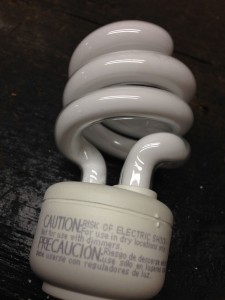CFL Bulbs Contain Mercury. What About Broken Bulbs?
 This morning, as I crunched on my English muffin, washed down periodically with sips of OJ, I perused the Erie Times News, and in so doing, discovered something shocking. It has nothing to do with the Malaysian plane disappearance, fracking under Pennsylvania parks, or the new garbage-fee plan. It has to do with your everyday light bulb.
This morning, as I crunched on my English muffin, washed down periodically with sips of OJ, I perused the Erie Times News, and in so doing, discovered something shocking. It has nothing to do with the Malaysian plane disappearance, fracking under Pennsylvania parks, or the new garbage-fee plan. It has to do with your everyday light bulb.
That would be the new version of your everyday light bulb.
You know, the CFL (compact fluorescent light) bulb that is replacing your inefficient incandescent, whether you like it or not. I suppose I like the fact that CFLs are sturdier and last longer, but I do think that we should all be aware of the dangers they pose when broken.
What shocked me was that Heloise said the first thing you’re supposed to do, if you break a CFL bulb, is to get everyone out of the house.
What?
Thanks to Heloise, who quoted the EPA guidelines in her answer to a concerned consumer, I’m reminded of the disposal warnings for CFLs and mindful that there needs to be a better dissemination of information, rather than one tucked away on an EPA Website. There’s no such warning on the light bulbs themselves at this time.
Remember the days when we had public-service announcements on TV that warned us to take all of our antibiotics, even if we felt better? If there have been such PSAs on live TV, I apologize. I watch most of my favorite shows on the DVR.
Here’s a cut-and-paste from the EPA advice on cleaning up a broken CFL light bulb (It’s long, so scroll down for my closing remarks, if you don’t want to read it all):
Before Cleanup
- Have people and pets leave the room. [Heloise said the EPA advises everyone to get out of the HOUSE. So, I felt a little bit better seeing that we only need to clear the ROOM.]
- Air out the room for 5-10 minutes by opening a window or door to the outdoor environment.
- Shut off the central forced air heating/air-conditioning system, if you have one.
- Collect materials needed to clean up broken bulb:
- DO NOT VACUUM. Vacuuming is not recommended unless broken glass remains after all other cleanup steps have been taken. Vacuuming could spread mercury-containing powder or mercury vapor.
- Be thorough in collecting broken glass and visible powder. Scoop up glass fragments and powder using stiff paper or cardboard. Use sticky tape, such as duct tape, to pick up any remaining small glass fragments and powder. Place the used tape in the glass jar or plastic bag. See the detailed cleanup instructions for more information, and for differences in cleaning up hard surfaces versus carpeting or rugs.
- Place cleanup materials in a sealable container.
- Promptly place all bulb debris and cleanup materials, including vacuum cleaner bags, outdoors in a trash container or protected area until materials can be disposed of. Avoid leaving any bulb fragments or cleanup materials indoors.
- Next, check with your local government about disposal requirements in your area, because some localities require fluorescent bulbs (broken or unbroken) be taken to a local recycling center. If there is no such requirement in your area, you can dispose of the materials with your household trash.
- If practical, continue to air out the room where the bulb was broken and leave the heating/air conditioning system shut off for several hours.
- stiff paper or cardboard;
- sticky tape;
- damp paper towels or disposable wet wipes (for hard surfaces); and
- a glass jar with a metal lid or a sealable plastic bag.
During Cleanup
- DO NOT VACUUM. Vacuuming is not recommended unless broken glass remains after all other cleanup steps have been taken. Vacuuming could spread mercury-containing powder or mercury vapor.
- Be thorough in collecting broken glass and visible powder. Scoop up glass fragments and powder using stiff paper or cardboard. Use sticky tape, such as duct tape, to pick up any remaining small glass fragments and powder. Place the used tape in the glass jar or plastic bag. See the detailed cleanup instructions for more information, and for differences in cleaning up hard surfaces versus carpeting or rugs.
- Place cleanup materials in a sealable container.
After Cleanup
- Promptly place all bulb debris and cleanup materials, including vacuum cleaner bags, outdoors in a trash container or protected area until materials can be disposed of. Avoid leaving any bulb fragments or cleanup materials indoors.
- Next, check with your local government about disposal requirements in your area, because some localities require fluorescent bulbs (broken or unbroken) be taken to a local recycling center. If there is no such requirement in your area, you can dispose of the materials with your household trash.
- If practical, continue to air out the room where the bulb was broken and leave the heating/air conditioning system shut off for several hours.
Now, those were the quick instructions. If you didn’t notice above, there’s also an option for more detailed instructions . Oy gevalt!
Oh, and remember not to toss CFLs in the trash, like you did with incandescents. Some states require recycling of CFL bulbs, but if yours doesn’t, many retailers, such as Ace Hardware, Lowe’s, and Home Depot, will recycle your bulbs for you: http://www2.epa.gov/cfl/recycling-and-disposal-after-cfl-burns-out#whererecycle
So, there you go. If you break a CFL bulb, please remember the “simple” instructions above, or visit the EPA Website. And please recycle your CFL bulbs. Better yet, you might want to fork over the extra bucks and buy LED bulbs. They last longer. And I haven’t heard about any safety hazards with those yet . . .

Ann Silverthorn is a writer who won’t be classified or categorized. One day she’s writing about her Cairn Terrier rescues, Nutmeg and Nora, and the next, she’s posting about a business topic, consumer tip, or research subject. Imagine the two of you are meeting for coffee, and she wants to share something new, interesting, or funny.




Wow, who knew? Thanks for the info, Ann. Actually I always clean up the light bulb debris with stickytape. When there are dogs in the house, who knows what they will decide to lick….
i have three questions:
1. if you have to get everyone out of the room how is it safe for the person cleaning up the bulb?
2. why do you need to take these precautions? what does mercury do to you?
3. if the makers know about the dangers of the bulb why are we using them?
i know nothing about these bulbs, i just use them but don’t know why i use them.